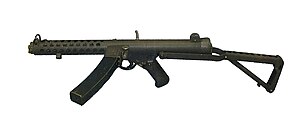L2A3
| Sterling submachine gun | |
|---|---|

Sterling L2A3 (Mark 4) submachine gun
|
|
| Type | Submachine gun |
| Place of origin | United Kingdom |
| Service history | |
| In service | 1944–Present |
| Used by | See Users |
| Wars |
World War II Suez Crisis Aden Emergency Indonesia–Malaysia confrontation Cold War Vietnam War Falklands War The Troubles Gulf War (final batch) |
| Production history | |
| Designer | George William Patchett |
| Designed | 1944 |
| Manufacturer | Sterling Armaments Company |
| No. built | 400,000+ |
| Variants | See Variants |
| Specifications | |
| Weight | 2.7 kilograms (6.0 lb) |
| Length | 686 millimetres (27.0 in) Folded stock: 481 millimetres (18.9 in) |
| Barrel length | 196 millimetres (7.7 in) |
|
|
|
| Cartridge |
9×19mm Parabellum 7.62×51mm NATO (Battle Rifle variant) |
| Action | Blowback and Lever-delayed blowback (Battle Rifle variant) |
| Rate of fire | 550 round/min |
| Effective firing range | 200 metres (220 yd) Suppressed: 50–100 metres (55–109 yd) |
| Feed system | 34-round box magazine |
| Sights | Iron sights |
| Sterling submachine gun | |
|
|
|
|
|
|
|
|
The Sterling submachine gun is a British submachine gun. It was tested with the British Army in 1944–1945 as a replacement for the Sten but it did not start to replace it until 1953. It remained in use until 1994, when it was phased out as the L85A1 assault rifle was phased in.
In 1944, the British General Staff issued a specification for a new submachine gun. It stated that the weapon should weigh no more than six pounds (2.7 kg), should fire 9×19mm Parabellum ammunition, have a rate of fire of no more than 500 rounds per minute and be sufficiently accurate to allow five consecutive shots (fired in semi-automatic mode) to be placed inside a one-foot-square target at a distance of 100 yd (91 m).
To meet the new requirement, George William Patchett, the chief designer at the Sterling Armaments Company of Dagenham, submitted a sample weapon of new design in early 1944. The first Patchett prototype gun was similar to the Sten insofar as its cocking handle (and the slot it moved back and forth in) was placed in line of sight with the ejection port though it was redesigned soon afterwards and moved up to a slightly offset position. The army quickly recognised the Patchett's potential (i.e. significantly increased accuracy and reliability when compared with the Sten) and ordered 120 examples for trials. Towards the end of the Second World War, some of these trial samples were used in combat by airborne troops during the battle of Arnhem and by special forces at other locations in Northern Europe where it was officially known as the Patchett Machine Carbine Mk 1. For example, a Patchett submachine gun (serial numbered 078 and now held by the Imperial War Museum), was carried in action by Colonel Robert W.P. Dawson while he was Commanding Officer of No. 4 Commando, during the attack on Walcheren as part of Operation Infatuate in November 1944. Because the Patchett/Sterling can use straight Sten submachine gun magazines as well as the curved Sterling design, there were no interoperability problems.
...
Wikipedia
